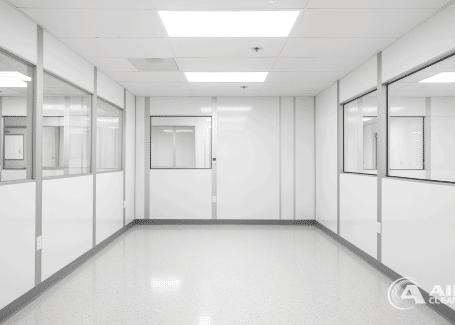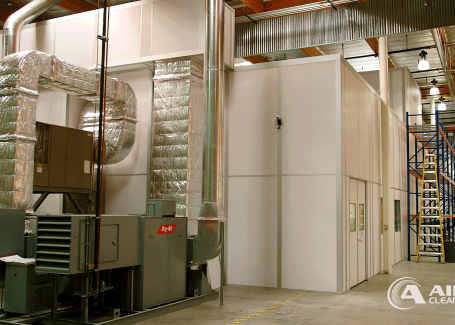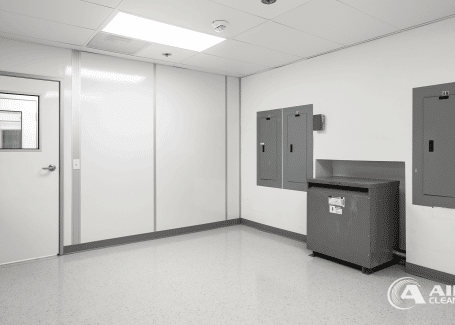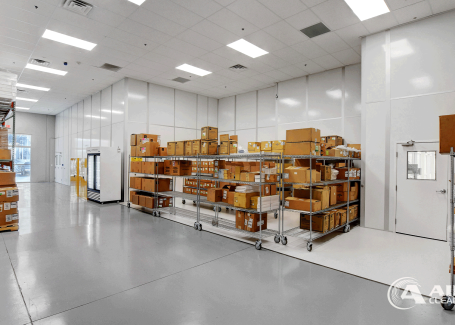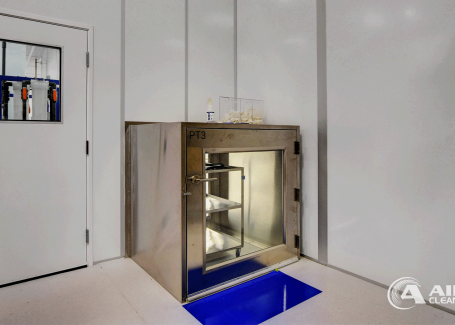Animal Health Cleanrooms
Every facility investment in veterinary pharmaceuticals, livestock diagnostics, or animal research comes down to one truth: you need a compliant clean air space. Not just any room, but a certified cleanroom. It’s your license to operate.
Without a compliant, properly designed cleanroom, you are unprotected: assays stop and start, vaccine batches are rejected or cross-contaminated, and regulatory delays pile up. Each failure wastes time, money, and credibility.
That’s what defines animal health cleanrooms: whether for vaccines, diagnostics, or animal testing, they’re not just engineered to exist, but engineered to solve the blind spots most facilities overlook.

Here’s What Most Cleanroom Providers Overlook
- Zoonotic Risk Factors: Labs deal with pathogens that can jump from animals to humans. This changes everything, including airflow, containment, PPE, and pressure zones.
- Variable ISO Zones: Animal housing, sample prep, and fill/finish areas don’t all require the same ISO 14644 class. Most providers never clarify if you need ISO 5, ISO 7, or ISO 8.
- Containment Protocols: Biosafety levels (BSL-2/3) and risk groups are non-negotiable. They dictate how your lab must be structured, validated, and operated.
- Lifecycle Economics: ROI isn’t just about the initial build. Hygiene depends on surfaces, maintenance, validation, and energy efficiency.
These blind spots leave organizations overpaying for construction, failing audits, and losing market share.
What Animal Health Cleanrooms Really Need
Let’s focus on the essentials:
- Reliable Sterility: Cleanrooms must maintain absolute cleanliness with advanced filtration (HEPA/ULPA), smooth airflow, and carefully controlled air pressure zones. This is vital because life-saving vaccines, diagnostics, and medicines depend on it.
- Regulatory Compliance: These cleanrooms need to meet strict standards like ISO 14644, FDA veterinary GMP, WHO, and WOAH guidelines. Passing inspections the first time around is crucial.
- Protecting Both People and Products: For work involving dangerous pathogens, negative-pressure rooms are a must to stop contamination. Facilities should have airlocks for staff and special pass-through chambers for materials—no cutting corners.
- Scalable and Flexible Design: As research, vaccine production, or diagnostics grow or change, the cleanroom should adapt easily without shutting down operations.
- Built to Last and Easy to Clean: Surfaces should not shed particles and must resist chemicals used for frequent disinfection. Designs should include hygienic, smooth finishes and joints that prevent dirt buildup.
Anything less risks safety. A ‘cleanroom lite’ approach just isn’t good enough.
Where Cleanrooms Are Needed in Animal Health
Whether in veterinary pharmaceuticals, diagnostics, or research, every area requires a clean, controlled environment.
- Veterinary Vaccine Production: Making vaccines for diseases like rabies, avian flu, and livestock infections demands sterile conditions.
- Pharmaceutical Animal Care: Creating and dosing medicines requires safe, contaminant-free spaces.
- Diagnostic Labs: Preventing contamination is critical to avoid incorrect diagnoses.
- Animal Research Labs: Animals must be kept and studied under strictly controlled conditions.
- Field Cleanrooms: Temporary or mobile cleanrooms support emergency vaccine drives or animal health missions on site.
While each use case needs its own custom setup, every cleanroom must be compliant, safe, and dependable.
Design Features of Animal Health Cleanrooms
The devil is in the details when designing animal health cleanrooms. Here’s what leading facilities include:
- Wall Systems: Hardwall (FRP, melamine, coated steel, aluminum) for durability; softwall (vinyl) for flexibility; or hybrid builds for a little bit of both.
- Air Management: HEPA/ULPA with single pass and/or recirculating air, designed to meet ISO 14644 classifications.
- Containment: Negative-pressure zones with airlocks, plus biosafety cabinets for safe handling of live pathogens and viral vectors.
- Layout: Gowning rooms, pass-throughs, and material airlocks support effective workflow and contamination control.
- Surfaces: Non-porous and chemical-resistant finishes withstand disinfectants without degrading.
These features are not nice-to-haves. They’re the baseline for compliance, safety, and results.
How Modular Cleanrooms Can Benefit You
Stick-built cleanrooms are slow, expensive, and inflexible. Modular cleanrooms evolve and grow with animal health applications.
With faster deployment that drastically reduces construction time, vaccines, diagnostics, and animal studies can proceed more quickly. Built at lower cost than stick-built facilities, modular architecture reduces capital expenditure and helps achieve better ROI. Modular also supports sustainability, with optimized material, workflow, and energy use that improve efficiency and reduce waste.
In animal health, an industry with fast-moving demand, and where outbreaks of avian flu or livestock disease are common, modular isn’t just chic, it’s survival
Compliance in Animal Health Cleanrooms
Regulators don’t want to hear that your plant was “almost” in compliance. Either you comply or you don’t. Animal health cleanrooms should adhere to:
- FDA Veterinary GMP standards.
- ISO 14644 classifications (ISO 5–8, depending on the application).
- WHO requirements for veterinary vaccines.
- WOAH biosafety and biocontainment standards.
- Audits are not the time to find out what is broken. The right strategy ensures compliance is built in from the start, not bolted on later at significant cost.
Zoonotic Risk Control
Animal health cleanrooms handle pathogens that can jump from animals to humans. As a result, each must be carefully designed with this in mind, otherwise labs risk failed audits, rejected vaccine batches, and dangerous cross-contamination.
Built for Compliance
From FDA Veterinary GMP to ISO 14644, WHO, and WOAH biosafety, animal health cleanrooms have to meet strict standards. These facilities are made to pass audits, with compliance built in from the start, rather than bolted on later at higher costs.
Adaptable Design
In animal health, demand can shift overnight. An outbreak, a vaccine surge, or new diagnostic work can all change priorities fast. Modular cleanrooms are built to keep up. They install faster than stick-built facilities, cost less to launch, and can expand or reconfigure without shutting down production.
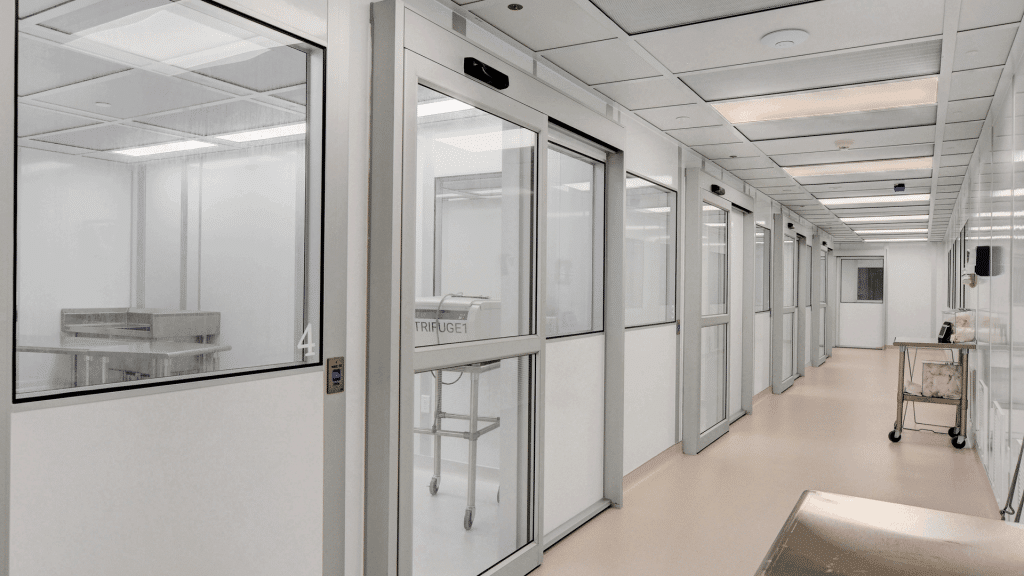
Contact
Leave Your Cleanroom in Expert Hands
FAQs About Animal Health Cleanrooms
How do animal health cleanrooms differ from human pharma cleanrooms?
Animal health cleanrooms must account for zoonotic risks, diverse pathogens, and varied housing/handling zones. The stakes are different—and the designs must reflect that.
What ISO classifications are required for veterinary vaccines?
Critical fill/finish operations require ISO 5. Support labs often operate at ISO 7, while animal housing and general zones may be ISO 8.
Can modular cleanrooms be relocated for temporary vaccination programs?
Yes. Portable cleanrooms can be deployed in the field—they’re ideal for livestock vaccination programs or outbreak response.
What containment is needed for live veterinary pathogens?
Biosafety Level 2 or 3, with negative-pressure containment, airlocks, HEPA filtration, and validated airflow regimes.


